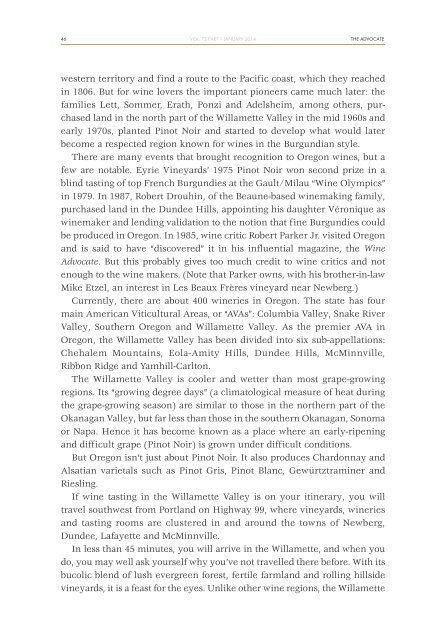Advocate Jan 2014
Advocate Jan 2014
Advocate Jan 2014
You also want an ePaper? Increase the reach of your titles
YUMPU automatically turns print PDFs into web optimized ePapers that Google loves.
46 VOL. 72 PART 1 JANUARY <strong>2014</strong><br />
THE ADVOCATE<br />
western territory and find a route to the Pacific coast, which they reached<br />
in 1806. But for wine lovers the important pioneers came much later: the<br />
families Lett, Sommer, Erath, Ponzi and Adelsheim, among others, purchased<br />
land in the north part of the Willamette Valley in the mid 1960s and<br />
early 1970s, planted Pinot Noir and started to develop what would later<br />
become a respected region known for wines in the Burgundian style.<br />
There are many events that brought recognition to Oregon wines, but a<br />
few are notable. Eyrie Vineyards’ 1975 Pinot Noir won second prize in a<br />
blind tasting of top French Burgundies at the Gault/Milau “Wine Olympics”<br />
in 1979. In 1987, Robert Drouhin, of the Beaune-based winemaking family,<br />
purchased land in the Dundee Hills, appointing his daughter Véronique as<br />
winemaker and lending validation to the notion that fine Burgundies could<br />
be produced in Oregon. In 1985, wine critic Robert Parker Jr. visited Oregon<br />
and is said to have “discovered” it in his influential magazine, the Wine<br />
<strong>Advocate</strong>. But this probably gives too much credit to wine critics and not<br />
enough to the wine makers. (Note that Parker owns, with his brother-in-law<br />
Mike Etzel, an interest in Les Beaux Frères vineyard near Newberg.)<br />
Currently, there are about 400 wineries in Oregon. The state has four<br />
main American Viticultural Areas, or “AVAs”: Columbia Valley, Snake River<br />
Valley, Southern Oregon and Willamette Valley. As the premier AVA in<br />
Oregon, the Willamette Valley has been divided into six sub-appellations:<br />
Chehalem Mountains, Eola-Amity Hills, Dundee Hills, McMinnville,<br />
Ribbon Ridge and Yamhill-Carlton.<br />
The Willamette Valley is cooler and wetter than most grape-growing<br />
regions. Its “growing degree days” (a climatological measure of heat during<br />
the grape-growing season) are similar to those in the northern part of the<br />
Okanagan Valley, but far less than those in the southern Okanagan, Sonoma<br />
or Napa. Hence it has become known as a place where an early-ripening<br />
and difficult grape (Pinot Noir) is grown under difficult conditions.<br />
But Oregon isn’t just about Pinot Noir. It also produces Chardonnay and<br />
Alsatian varietals such as Pinot Gris, Pinot Blanc, Gewürtztraminer and<br />
Riesling.<br />
If wine tasting in the Willamette Valley is on your itinerary, you will<br />
travel southwest from Portland on Highway 99, where vineyards, wineries<br />
and tasting rooms are clustered in and around the towns of Newberg,<br />
Dundee, Lafayette and McMinnville.<br />
In less than 45 minutes, you will arrive in the Willamette, and when you<br />
do, you may well ask yourself why you’ve not travelled there before. With its<br />
bucolic blend of lush evergreen forest, fertile farmland and rolling hillside<br />
vineyards, it is a feast for the eyes. Unlike other wine regions, the Willamette


